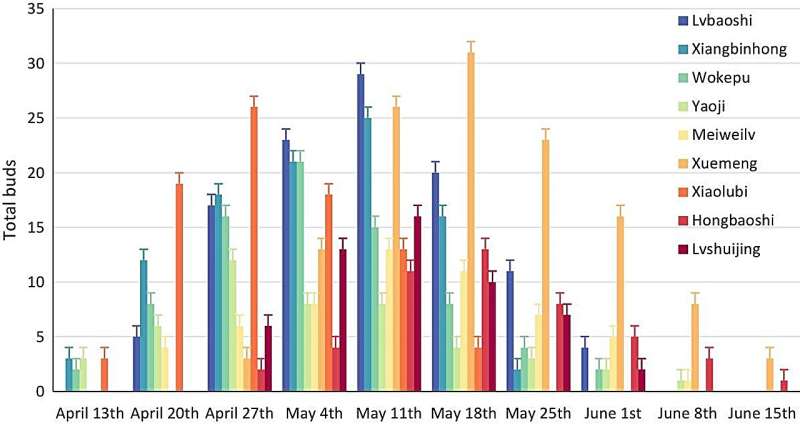This article has been reviewed according to Science X's editorial process and policies. Editors have highlighted the following attributes while ensuring the content's credibility:
fact-checked
proofread
Comprehensive evaluation identifies top finger lime varieties for commercial and ornamental use

A research team has conducted a comprehensive evaluation of nine finger lime varieties, identifying key differences in fruit peel color and suitability for commercial production. Xiangbinhong emerged as the best variety for commercial production, while Xuemeng was ideal for ornamental shrubs or grafting rootstocks.
The findings are valuable for enhancing finger lime breeding and cultivation techniques, which can lead to improved production strategies and greater economic returns in the horticultural industry. This research also provides crucial reference data for future agricultural advancements.
The finger lime [Microcitrus australasica (F. Muell.) Swingle], native to eastern Australia's subtropical rainforests, was introduced to China in 1977 and has been successfully cultivated, particularly in Hainan Province.
Despite its popularity and high market demand, challenges persist in the industry's expansion, including unclear classification criteria and limited information on fruit composition and ideal cultivation techniques.
A study published in Tropical Plants aims to analyze the quality and genetic resources of current varieties, ensuring sustainable finger lime production in China.
In this study, the botanical characteristics, phenological performance, fruit quality, and chloroplast genome structure of nine finger lime varieties (Hongbaoshi, Lvbaoshi, Lvshuijing, Meiweilv, Wokepu, Xiangbinhong, Xiaolubi, Xuemeng, Yaoji) were analyzed. The research revealed significant variation in tree height, trunk, and branch thickness, with Hongbaosh (297 cm) being the tallest and Xiaolubi (91.6 cm) the shortest.
Thorn density and length varied, with Meiweilv (18–24 thorns per branch) having the most thorns and Xuemeng (9–14 thorns per branch) the least. Leaf morphology showed differences in size and shape, and flower morphology varied in bud size, petal length, and style length.
The fruit shape, color, and oil gland visibility differed across varieties, with Hongbaoshi (29.3 g per fruit, with a length of 106.8 mm and diameter of 22.6 mm) producing the heaviest fruits and Xiaolubi (4.7 g per fruit, with a length of 48.6 mm and a diameter of 11.3 mm) the lightest.
And the nine finger lime varieties could be divided into two broad categories, according to the differences in their peel color: a dark-skinned group and a light-skinned group. Phenological performance indicated that dark-skinned varieties began flowering earlier than light-skinned ones, with Xiangbinhong excelling in flowering and fruiting rates.
Chloroplast genome analysis showed minimal differences in genome length among nine varieties, with typical angiosperm tetrad structures and consistent GC content (38.4%). Phylogenetic analysis confirmed close evolutionary relationships among the varieties, closely related to Citrus medica and Citrus indica.
According to the study's senior researcher, Hua-Feng Wang, "The results of this study can provide a theoretical basis and tool for the study of genetic diversity conservation and phylogenetic relationships among finger limes."
In summary, this study evaluated nine finger lime varieties, identifying key traits and classifying them by peel color. Xiangbinhong was deemed best for commercial production due to its excellent fruit qualities. The chloroplast genome analysis showed typical angiosperm structures and close ties to C. medica and C. indica.
Future research should focus on refining classification systems and improving genetic and phenotypic understanding to support sustainable finger lime production.
More information: Wei Lv et al, An investigation of germplasm resources and phylogenetic analysis of finger lime in Hainan Province, China, Tropical Plants (2024). DOI: 10.48130/tp-0024-0015
Provided by TranSpread




















